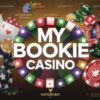Horse racing form shows past race marks. Each form element attaches to a result. This guide ties each number and code to a feature of race performance. New readers get a path to understand race data using short, connected clues.
What is Horse Racing Form?
Form comes as numbers and letters on racecards or performance reports. Each mark links to a race result or a race event. For example, the line “124” ties a first, a second, and a fourth place. Reading these links helps you see race trends.
Common Form Symbols and Abbreviations
- Numbers 1-9: Each number pairs with a finishing spot.
- 0: A mark for finishing out of the main places.
- – (Hyphen): This sign divides different racing seasons.
- / (Slash): This mark ties to a longer absence from races.
- PU: This code shows that the jockey stopped the horse before the end.
- F: This letter ties to a fall during the race.
- UR, U: These marks show that the rider lost his seat.
- BD: This code means the horse was brought down.
Extra marks attach to special wins:
- C: Wins on the same course attach here.
- D: Wins at the same distance attach here.
- CD: The combined mark ties the course and distance together.
- BF: Marks a case when the horse did not keep its favorite edge.

Form is More Than Numbers
Numbers and letters do not show the full race. Each mark connects to details like interference, running style, track state, and rider choices. A horse that finishes low may tie its result to bad luck or poor track conditions. Watching replays and checking notes help bring these links to light.
Bounce Factor: Returns After a Layoff
A horse that rests for long links a good comeback with lower later running. It connects freshness with a quick win and then a drop in results. This factor binds a surge after a break with slower recovery later.
Understanding U.S. Style Past Performance Form
U.S. form lines tie many details in one line:
- Date and track: Attach when and where the race happened.
- Distance and track condition: These numbers link to race setup and pace splits.
- Class and pace ratings: They join the horse’s competition level with its running style.
- Jockey, weight, odds: Each ties to how the race was run.
- Comments: These short notes bind explanations to race choices.
Practical Tools: Racecards and Replays
Interactive racecards and video tools tie past form notes with race footage. You click a racecard and see numbers attach closely to real action. This pair of data fix hidden clues such as pace change or track bias.
Responsible Engagement and Legal Considerations
Racing and betting have set rules. Age limits and licensing tie to legal guidelines. You must keep safe by reading race data with care. Trusted sites link help resources for betting issues.
Summary
Learning to read race form ties you to smarter race picks. Each mark links with a detail: numbers with positions, codes with incidents, and notes with race facts. As you add context with replays and extra notes, you build a full view of the race. Use this guide as a base for careful and smart reading of race data.
This article is for study only and does not promote betting. Please follow your local guidelines and bet safely.






























